2012 Peugeot 3008 Hybrid 4 roof
[x] Cancel search: roofPage 4 of 284

CONTENTS
FAMILIARISATION 4-25
IN
STRUMENTS and
CONTROLS 47-61
CHILD SAFETY 122-132
MULTIFUNCTION
SCREEN
S62-70
SAFETY 133-142 COMFORT 71-8
4
ACCESS 85-99
VISIBILITY 100-110FITTINGS 111-12
1
Instrument panels...........................47Indicator and warning lamps..........49Indicators........................................57Adjustment buttons.........................61
Child seats....................................122ISOFIX child seats........................129Child lock ......................................132
Screen C (Peugeot ConnectSound (RD5))...............................6216/9 high definition retractable colour
screen (Peugeot Connect Media).....65
Direction indicators.......................133Hazard warning lamps..................133Horn ..............................................133ESC system..................................134Front seat belts.............................136Airbags .........................................139
Heating and Ventilation ..................71Rear screen demist - defrost..........72Dual-zone digital air conditioning......73Front seats .....................................76Rear seats......................................80Steering wheel adjustment.............82Mirrors............................................83
Remote control key........................85Alarm ..............................................90Electric windows.............................92Doors..............................................94Boot................................................96Lower tailgate.................................97Fuel tank.........................................98Misfuel prevention (Diesel) .............99
Lighting controls...........................100LED lamps ....................................102Daytime running lamps.................102Automatic illumination
of headlamps..............................103Headlamp adjustment..................104Wiper controls ..............................105Automatic rain sensitive wipers .....107Courtesy lamps............................108Interior mood lighting....................109Boot lamp......................................110
Interior fittings................................111Front armrest.................................113Rear multimedia............................115Panoramic sunroof........................f117Boot fittings....................................118HYBRID SYSTEM 26-46
Presentation...................................26Ready lamp....................................30HYbrid4 mode selector...................r31Energy consumption / generationindicator........................................r34Display of hybrid power flow..........35Eco off............................................f38Eco-driving......................................39Consumption ..................................41High voltage battery.......................42Vehicle recovery.............................46
Page 5 of 284

CONTENTS
ALPHABETICALINDEX 271-274
DRIVING 143-162
CHECK
S 163-169
PRACTICAL
INFORMATION 170-199
TECHNICAL DATA 200-204
AUDIO EQUIPMENTand TELEMATICS 205-270
Electric parking brake...................143Hill start assist..............................148Head-up display...........................151Speed limiter................................r153Cruise control...............................1556-speed electronic gear control gearbox......................................157Parking sensors ............................161
Bonnet..........................................164Running out of fuel (Diesel)..........165Diesel engine................................166Checking levels............................167Checks..........................................168
Temporary puncture repair kit......170Changing a wheel.........................176Changing a bulb...........................179Changing a fuse ...........................18312 V Battery..................................190Energy economy mode................193Changing a wiper blade...............194Recovering the vehicle.................194Vehicle recovery ...........................195Towing a trailer.............................r196Fitting roof bars............................197Very cold climate screen..............197Accessories..................................198
Electric motor...............................r200Diesel engine................................201Diesel weights ..............................202Dimensions ...................................203Identification markings..................204
VISUAL SEARCH 275-279
Emergency or assistance.............205Peugeot Connect Media Navigation(NG4 3D)....................................209Peugeot Connect Sound (RD5)....253
Page 10 of 284
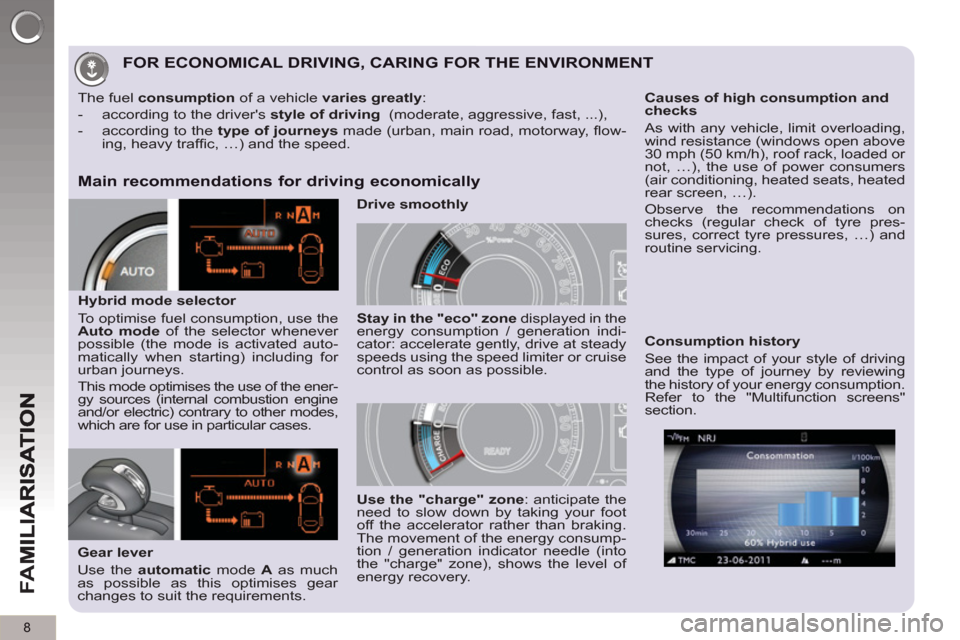
8
FA
M
FOR ECONOMICAL DRIVING, CARING FOR THE ENVIRONMENT
Main recommendations for driving economically
Gear lever
Use the automatic
mode A
as much
as possible as this optimises gear
changes to suit the requirements.
The fuel consumption
of a vehicle varies greatly
:
- according to the driver's style of driving
(moderate, aggressive, fast, ...),
- according to the type of journeys
made (urban, main road, motorway, fl ow-
ing, heavy traffi c, …) and the speed.
Hybrid mode selector
To optimise fuel consumption, use the
Auto
mode
of the selector whenever
possible (the mode is activated auto-
matically when starting) including for
urban journeys.
This mode optimises the use of the ener-
gy sources (internal combustion engine
and/or electric) contrary to other modes,
which are for use in particular cases.
Stay in the "eco" zone
displayed in the
energy consumption / generation indi-
cator: accelerate gently, drive at steady
speeds using the speed limiter or cruise
control as soon as possible.
Causes of high consumption and
checks
As with any vehicle, limit overloading,
wind resistance (windows open above
30 mph (50 km/h), roof rack, loaded or
not, …), the use of power consumers
(air conditioning, heated seats, heated
rear screen, …).
Observe the recommendations on
checks (regular check of tyre pres-
sures, correct tyre pressures, …) and
routine servicing.
Consumption history
See the impact of your style of driving
and the type of journey by reviewing
the history of your energy consumption.
Refer to the "Multifunction screens"
section.
Use the "charge"
zone: anticipate the
need to slow down by taking your foot
off the accelerator rather than braking.
The movement of the energy consump-
tion / generation indicator needle (into
the "charge" zone), shows the level of
energy recovery.
Drive smoothly
Page 11 of 284
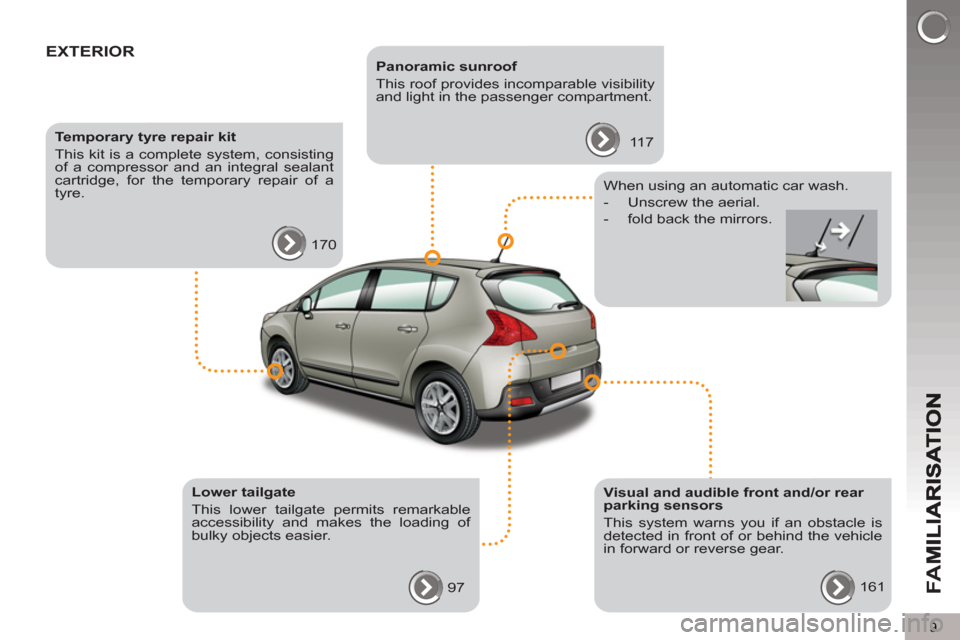
9
FA
M
EXTERIOR
Panoramic sunroof
This roof provides incomparable visibility
and light in the passenger compartment.
117
Temporary tyre repair kit
This kit is a complete system, consisting
of a compressor and an integral sealant
cartridge, for the temporary repair of a
tyre.
170
Lower tailgate
This lower tailgate permits remarkable
accessibility and makes the loading of
bulky objects easier.
97
Visual and audible front and/or rear
parking sensors
This system warns you if an obstacle is
detected in front of or behind the vehicle
in forward or reverse gear.
161
When using an automatic car wash.
- Unscrew the aerial.
- fold back the mirrors.
Page 41 of 284
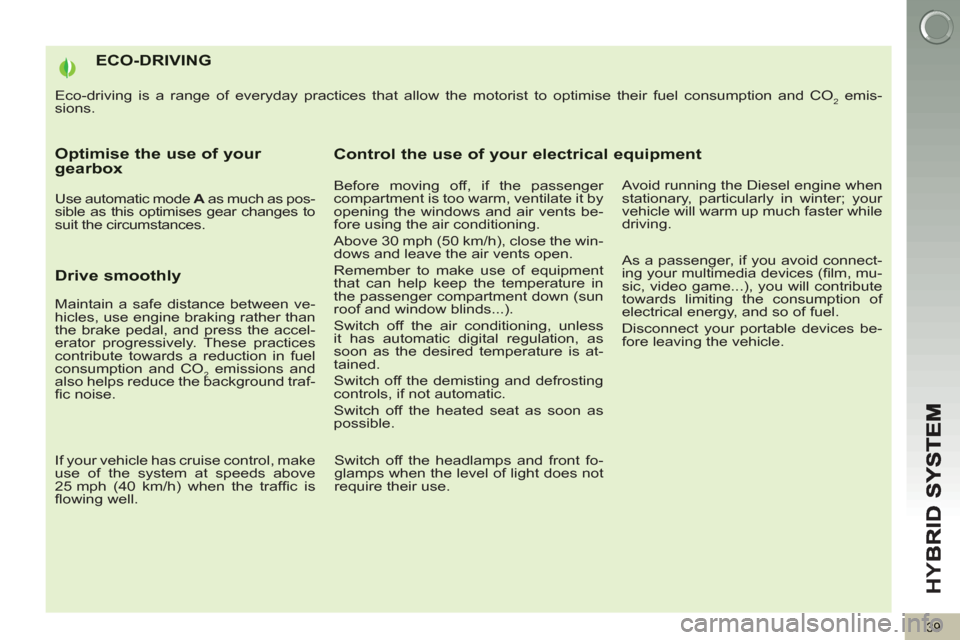
HY
B
39
ECO-DRIVING
Eco-driving is a range of everyday practices that allow the motorist to optimise their fuel consumption and CO2 emis-
sions.
Optimise the use of your gearbox
Use automatic mode A
as much as pos-
sible as this optimises gear changes to
suit the circumstances.
Drive smoothly
If your vehicle has cruise control, make
use of the system at speeds above
25 mph (40 km/h) when the traffi c is
fl owing well.
Control the use of your electrical equipment
Before moving off, if the passenger
compartment is too warm, ventilate it by
opening the windows and air vents be-
fore using the air conditioning.
Above 30 mph (50 km/h), close the win-
dows and leave the air vents open.
Remember to make use of equipment
that can help keep the temperature in
the passenger compartment down (sun
roof and window blinds...).
Switch off the air conditioning, unless
it has automatic digital regulation, as
soon as the desired temperature is at-
tained.
Switch off the demisting and defrosting
controls, if not automatic.
Switch off the heated seat as soon as
possible.
Switch off the headlamps and front fo-
glamps when the level of light does not
require their use.
Avoid running the Diesel engine when
stationary, particularly in winter; your
vehicle will warm up much faster while
driving.
As a passenger, if you avoid connect-
ing your multimedia devices (fi lm, mu-
sic, video game...), you will contribute
towards limiting the consumption of
electrical energy, and so of fuel.
Disconnect your portable devices be-
fore leaving the vehicle.
Maintain a safe distance between ve-
hicles, use engine braking rather than
the brake pedal, and press the accel-
erator progressively. These practices
contribute towards a reduction in fuel
consumption and CO
2 emissions and
also helps reduce the background traf-
fi c noise.
Page 42 of 284
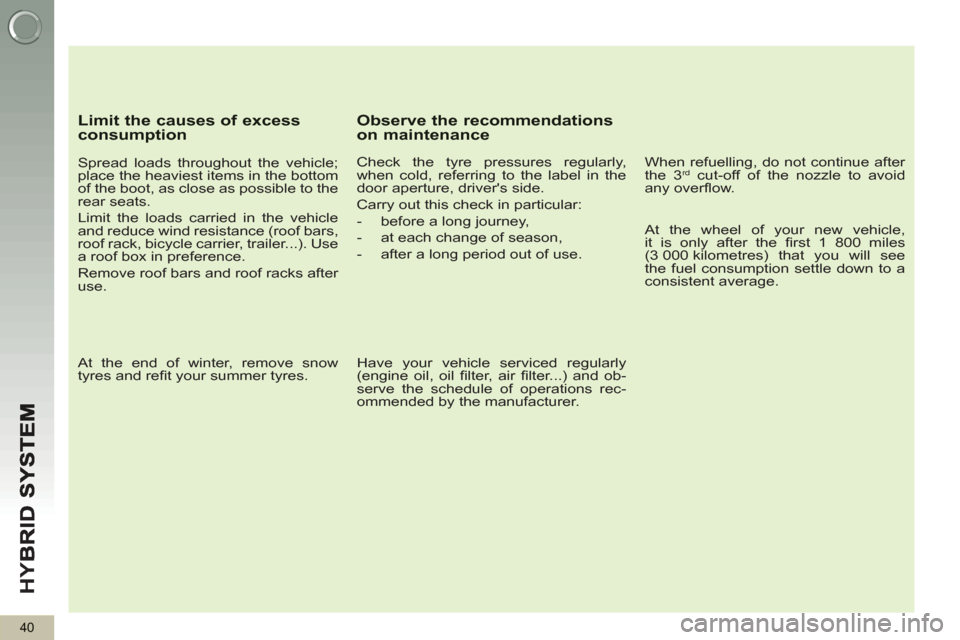
HY
B
40
Limit the causes of excess consumption
Spread loads throughout the vehicle;
place the heaviest items in the bottom
of the boot, as close as possible to the
rear seats.
Limit the loads carried in the vehicle
and reduce wind resistance (roof bars,
roof rack, bicycle carrier, trailer...). Use
a roof box in preference.
Remove roof bars and roof racks after
use.
At the end of winter, remove snow
tyres and refi t your summer tyres.
Observe the recommendationson maintenance
Check the tyre pressures regularly,
when cold, referring to the label in the
door aperture, driver's side.
Carry out this check in particular:
- before a long journey,
- at each change of season,
- after a long period out of use.
Have your vehicle serviced regularly
(engine oil, oil fi lter, air fi lter...) and ob-
serve the schedule of operations rec-
ommended by the manufacturer.
When refuelling, do not continue after
the 3 rd cut-off of the nozzle to avoid
any overfl ow.
At the wheel of your new vehicle,
it is only after the fi rst 1 800 miles
(3 000 kilometres) that you will see
the fuel consumption settle down to a
consistent average.
Page 119 of 284
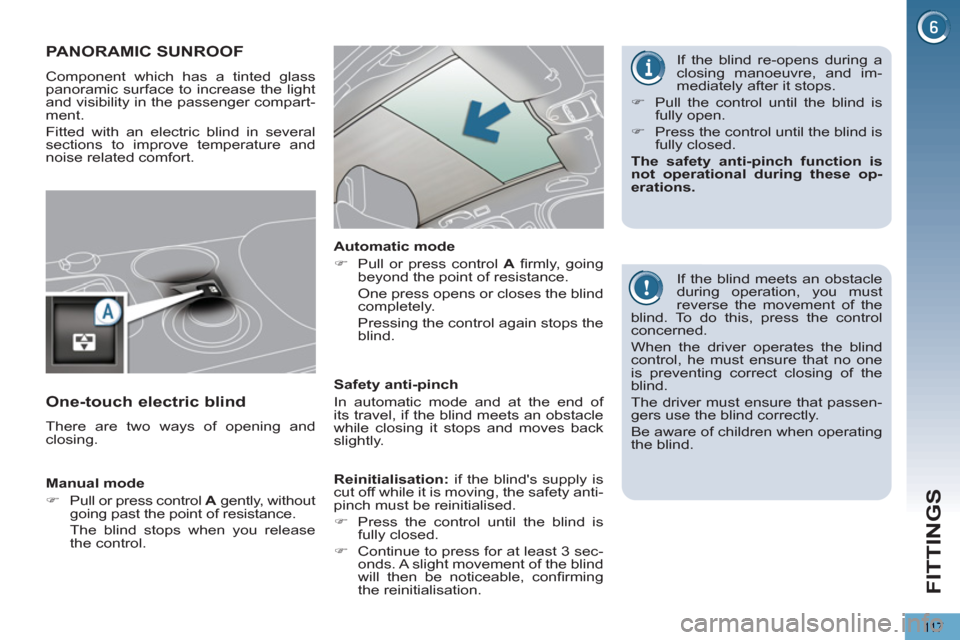
FITTINGS
11 7
PANORAMIC SUNROOF
Component which has a tinted glass
panoramic surface to increase the light
and visibility in the passenger compart-
ment.
Fitted with an electric blind in several
sections to improve temperature and
noise related comfort.
If the blind meets an obstacle
during operation, you must
reverse the movement of the
blind. To do this, press the control
concerned.
When the driver operates the blind
control, he must ensure that no one
is preventing correct closing of the
blind.
The driver must ensure that passen-
gers use the blind correctly.
Be aware of children when operating
the blind.
Manual mode
�)
Pull or press control A
gently, without
going past the point of resistance.
The blind stops when you release
the control.
Automatic mode
�)
Pull or press control A
fi rmly, going
beyond the point of resistance.
One press opens or closes the blind
completely.
Pressing the control again stops the
blind.
Safety anti-pinch
In automatic mode and at the end of
its travel, if the blind meets an obstacle
while closing it stops and moves back
slightly.
One-touch electric blind
There are two ways of opening and
closing.
If the blind re-opens during a
closing manoeuvre, and im-
mediately after it stops.
�)
Pull the control until the blind is
fully open.
�)
Press the control until the blind is
fully closed.
The safety anti-pinch function is
not operational during these op-
erations.
Reinitialisation:
if the blind's supply is
cut off while it is moving, the safety anti-
pinch must be reinitialised.
�)
Press the control until the blind is
fully closed.
�)
Continue to press for at least 3 sec-
onds. A slight movement of the blind
will then be noticeable, confi rming
the reinitialisation.
Page 144 of 284
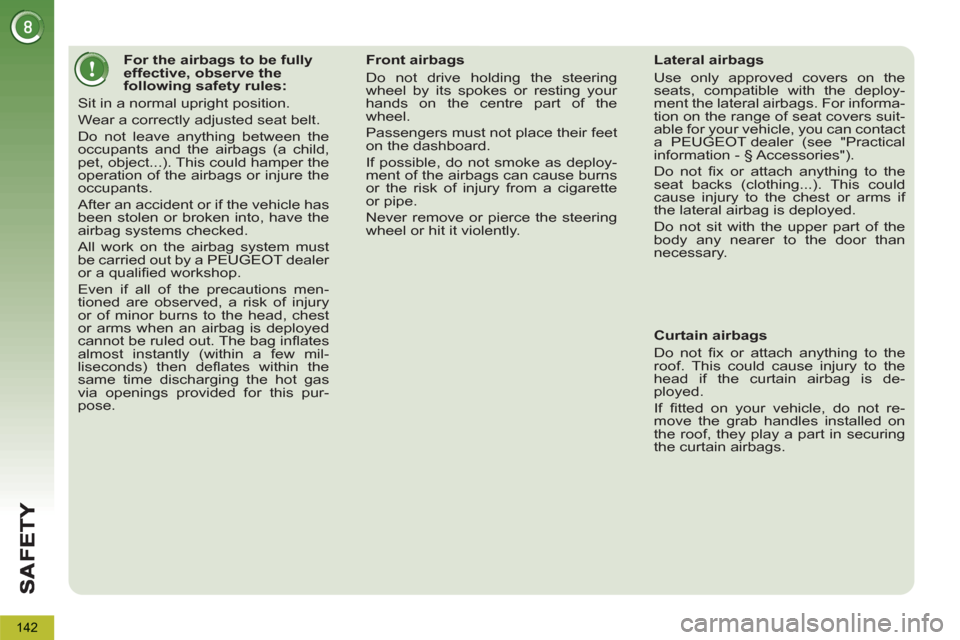
142
For the airbags to be fully
effective, observe the
following safety rules:
Sit in a normal upright position.
Wear a correctly adjusted seat belt.
Do not leave anything between the
occupants and the airbags (a child,
pet, object...). This could hamper the
operation of the airbags or injure the
occupants.
After an accident or if the vehicle has
been stolen or broken into, have the
airbag systems checked.
All work on the airbag system must
be carried out by a PEUGEOT dealer
or a qualifi ed workshop.
Even if all of the precautions men-
tioned are observed, a risk of injury
or of minor burns to the head, chest
or arms when an airbag is deployed
cannot be ruled out. The bag infl ates
almost instantly (within a few mil-
liseconds) then defl ates within the
same time discharging the hot gas
via openings provided for this pur-
pose.
Front airbags
Do not drive holding the steering
wheel by its spokes or resting your
hands on the centre part of the
wheel.
Passengers must not place their feet
on the dashboard.
If possible, do not smoke as deploy-
ment of the airbags can cause burns
or the risk of injury from a cigarette
or pipe.
Never remove or pierce the steering
wheel or hit it violently.
Lateral airbags
Use only approved covers on the
seats, compatible with the deploy-
ment the lateral airbags. For informa-
tion on the range of seat covers suit-
able for your vehicle, you can contact
a PEUGEOT dealer (see "Practical
information - § Accessories").
Do not fi x or attach anything to the
seat backs (clothing...). This could
cause injury to the chest or arms if
the lateral airbag is deployed.
Do not sit with the upper part of the
body any nearer to the door than
necessary.
Curtain airbags
Do not fi x or attach anything to the
roof. This could cause injury to the
head if the curtain airbag is de-
ployed.
If fi tted on your vehicle, do not re-
move the grab handles installed on
the roof, they play a part in securing
the curtain airbags.